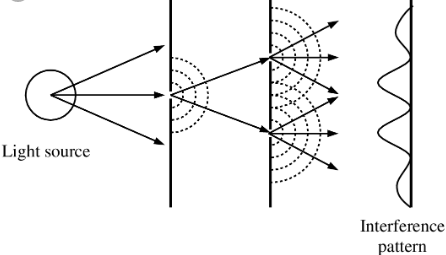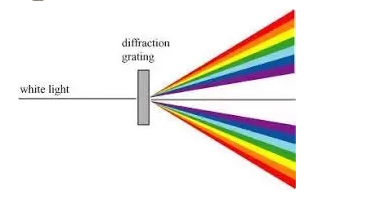What Is Interference Of Light Wave?

Interference of light wave is the phenomena whereby two light waves superpose to form a resultant wave of greater, lower or same amplitude. This phenomenon of interference of light was discovered by Thomas Young in 1801 AD. Interference can be classified as either constructive or destructive interference. Constructive and destructive interferences result from the interaction of waves that are correlated or coherent with each other, either because they come from the same source or because they have the same or nearly the same frequency. Interference effects can be observed with all types of waves, for example light, gravity waves, acoustic, matter waves, surface water waves or radio waves.
Conditions For Interference
- Path difference between light, rays should be an odd integral multiple of the wavelength of light.
- Light source should be monochromatic.
- The light source should be coherent, meaning they should be a subsidiary source and derived from a single source.
- The light source should be narrow and have the same intensity.
What You Need To Know About Interference
- Interference is a phenomenon whereby two waves superimpose forming a resultant wave of different amplitude.
- The waves emitted by two coherent sources travel in straight line.
- All bright fringes are of the same intensity.
- The points of minimum intensity show complete darkness.
- Width of the central maximum is same as that of the other bright fringes i.e fringe width is same for all fringes including central maxima.
- The spacing between different fringes displays uniformity in nature.
- The resolving power of an optical instrument does not depend on the phenomenon of interference.
- Minimum intensity may be zero.
- A slit or obstacle is not necessary for wave interference to take place.
- Interference through double slit forms interference fringes on the screen (Alternate and light bands or fringes).
What Is Diffraction Of Light Wave?

Diffraction in physics is a phenomenon whereby a wave encounters an obstacle or a slit. Diffraction of light waves is thus defined as the bending of light waves around the corners of an obstacle or through an aperture into the region of geometrical shadow of the obstacle/aperture. The diffracting object or aperture effectively becomes a secondary source of the propagating wave.
A very simple experiment of diffraction can be carried out by holding your hand in front of a light source and slowly closing two fingers while observing the light transmitted between them. As the fingers approach each other and come very close together, you begin to see a series of dark lines parallel to the fingers. The parallel lines are actually diffractions patterns. Diffraction also occurs when light is bent around particles that are on the same order of magnitude as the wavelength of the light.
What You Need To Know About Diffraction
- Diffraction of light is a phenomenon of bending of light around the corners of an obstacle or apertures and its consequent spreading into regions of its geometrical shadow.
- The light waves are bend at the corners and displaced from their straight line path.
- The intensity of bright fringes decreases as we move further from the central bright fringe on either side.
- The minimum intensity points are not completely dark.
- Width of central maximum is broader than other maxima and it’s double the fringe width.
- The spacing between different fringes is non-uniform.
- The resolving power of an optical instrument depends on the phenomenon of diffraction.
- Minimum intensity is not zero.
- For diffraction to take place, slit or obstacle is necessarily required.
- Diffraction through double slit produces interference. Therefore, alternate bright and dark fringes are formed.
Also Read: Difference Between Fraunhofer And Fresnel Diffraction
Difference Between Interference And Diffraction In Tabular Form
| BASIS OF COMPARISON | INTERFERENCE | DIFFRACTION |
| Description | Interference is a phenomenon whereby two waves superimpose forming a resultant wave of different amplitude. | Diffraction of light is a phenomenon of bending of light around the corners of an obstacle or apertures and its consequent spreading into regions of its geometrical shadow. |
| Waves | The waves emitted by two coherent sources travel in straight line. | The waves emitted by two coherent sources travel in straight line. |
| Intensity Of Bright Fringes | All bright fringes are of the same intensity. | The intensity of bright fringes decreases as we move further from the central bright fringe on either side. |
| Points of Minimum Intensity | The points of minimum intensity show complete darkness. | The minimum intensity points are not completely dark. |
| Width Of The Central Maximum | Width of the central maximum is same as that of the other bright fringes i.e fringe width is same for all fringes including central maxima. | Width of central maximum is broader than other maxima and it’s double the fringe width. |
| Spacing Between Fringes | The spacing between different fringes displays uniformity in nature. | The spacing between different fringes is non-uniform. |
| Resolving Power Of An Optical Instrument | The resolving power of an optical instrument does not depend on the phenomenon of interference. | The resolving power of an optical instrument depends on the phenomenon of diffraction. |
| Minimum Intensity | Minimum intensity may be zero. | Minimum intensity is not zero. |
| Slit Or Obstacle | A slit or obstacle is not necessary for wave interference to take place. | For diffraction to take place, slit or obstacle is necessarily required. |
| Double Slit | Interference through double slit forms interference fringes on the screen (Alternate and light bands or fringes). | Diffraction through double slit produces interference. Therefore, alternate bright and dark fringes are formed. |
Also Read: Difference Between Reflection And Refraction Of Light
Comments are closed.